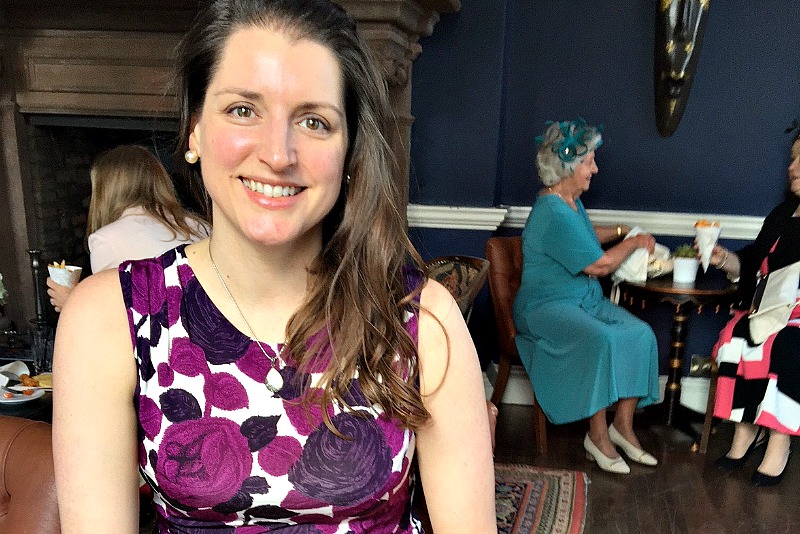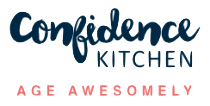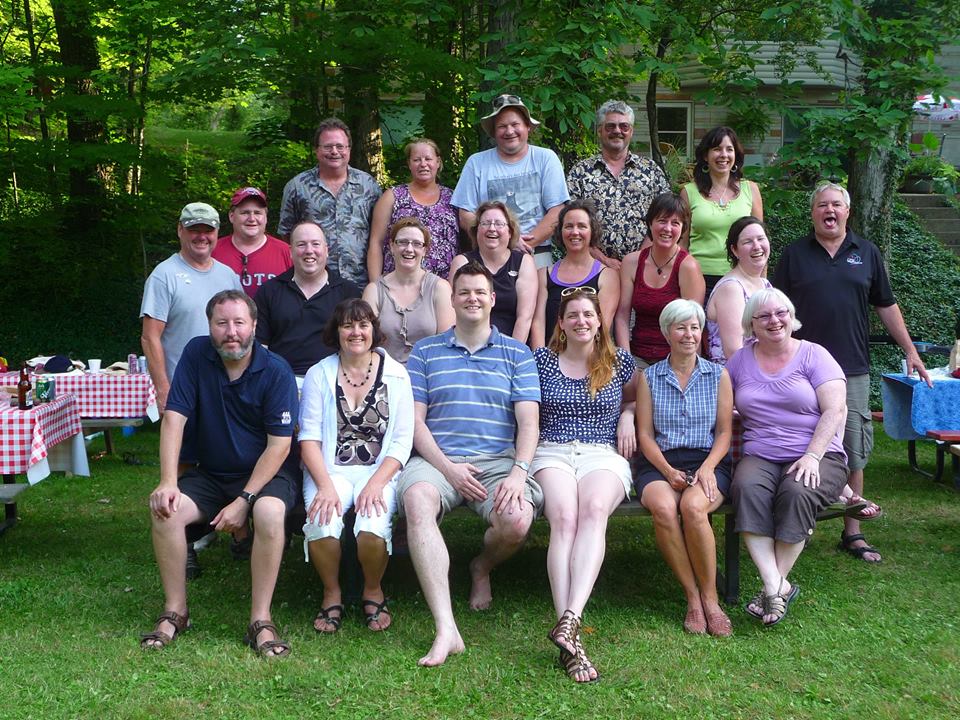What is familial hypercholesterolemia and how to thrive if you have it
Familial hypercholesterolemia is an inherited condition which leads to very high cholesterol levels. If you take away the word “familial”, then hypercholesterolemia itself simply means high blood cholesterol. As discussed often on this blog, in normal adults, high cholesterol is almost 100% manageable via lifestyle alone (without the need for prescription drugs like statins.)
In familial hypercholesterolemia, the reason for the high cholesterol is primarily genetic. The picture above is from my (very large) family reunion. These are most of my immediate cousins from my dad’s family which had 13 brothers and sisters. In families like mine, the mother or father passes along a gene to the child that interferes with the body’s ability to take cholesterol into the cells. The type of cholesterol impacted is the Low Density Lipoprotein-cholesterol (LDL-cholesterol). This means that the ability to remove LDL-cholesterol efficiently from the bloodstream is reduced. The condition results in a higher level of LDL-C in the bloodstream. (We used to think this was a very bad situation, and sometimes even a death sentence, but read on to see how the science has changed.)
If the child receives the gene from only one parent, it is called heterozygous familial hypercholesterolemia. In rare cases, the child will receive the gene from both parents (homozygous familial hypercholesterolemia). Depending on the number of faulty genes received, a person with familial hypercholesterolemia will have double (hetero) and sometimes four times (homo) the LDL cholesterol of the general population.
The prevalence of familial hypercholesterolemia
The prevalence of familial hypercholesterolemia varies worldwide. This could be due to different tracking systems for the disease in each country, or potentially different ethnic predispositions to the condition. Populations vary in their estimates from between one in 500 to one in 200. It is estimated that between 14 and 34 million individuals worldwide have the condition, but fewer than 15% of these cases are diagnosed. This means that millions of people throughout the world remain undiagnosed and are unaware that their eating patterns could be creating a significant and potentially fatal disease risk (see below on what you can do to minimize your risk).
Here are some general estimates of the condition by country:
- USA: About 1 in 500 have the heterozygous form of FH (around 600,000 Americans)
- UK: At least 1 in 500 have this condition (roughly 120,000 in the UK)
- Holland: Around 1 in 200 to 1 in 300 are affected (roughly 84,000 in Holland)
The bodily mechanism behind familial hypercholesterolemia
Despite all the negative press, LDL particles are actually just transport vehicles for cholesterol particles. Cholesterol is an important fatty building block for our body, however it cannot circulate in our blood on its own. It needs an LDL particle to act as a taxi to take it to cells where it can be used.
LDL receptors are found on cell walls in our bodies. They allow LDL particles that circulate in our blood to “dock” much like a spaceship docks onto a space station. Once the cholesterol docks, it is taken out of the bloodstream and used in the cell. Someone with familial hypercholesterolemia often has fewer of these LDL receptors (typically half the normal amount). When we have less LDL receptors available, fewer LDL particles can dock with our cells and therefore more LDL particles must stay circulating in our bloodstream. The good news is that more LDL in our bloodstream does not have to be a big deal. But, if we don’t know it’s there and eat a poor diet, then it can be deadly. If we do know it’s there, and we eat a healthy diet, the extra cholesterol does not need to negatively impact us.
How do we avoid atherosclerosis or arterial plaque if we have familial hypercholesterolemia?
The reason why many of us are scared of high cholesterol is because cholesterol can be changed through chemical processes into arterial plaque. So the excess LDL cholesterol circulating in the bodies of those of us with familial hypercholesterolemia can become trapped in the walls of blood vessels, eventually forming plaques, which cause narrowing arteries and eventually heart attacks.

Being diagnosed with familial hypercholesterolemia in 2011 opened my eyes to the easy things I could do to radically improve my health. I am now healthier than ever and do not have to take side-effect heavy medication to manage my condition.
This much is true. People with hypercholesterolemia in general and those with familial hypercholesterolemia in particular have excess cholesterol in our blood. What no one seems to talk about however, is that the excess cholesterol, in itself, is not bad. It actually can’t do anything to us on it’s own. We must, in a way, ignite it through our dietary choices. Of course I’m speaking metaphorically about fire, but I think it helps to picture cholesterol in your mind like tiny little matches, just circulating quietly and innocently through our bloodstream. If we never lit them on fire, they would circulate peacefully in our bodies.
The trouble comes when we create inflammation in our bodies through glucose disregulation among other things. Inflammation is what comes first and this can cause the cholesterol to become a problem. Nothing will happen until we light these matches on fire. Once we do this consistently, then we start to build the dreaded plaque formations on our artery walls. Whether we light the match, or not, is entirely in our control. We only light the match when we eat inflammation causing foods like refined sugar, refined flours, trans-fats, or processed foods. We can also ignite our cholesterol by not getting enough sleep, not exercising enough, or not reducing our stress levels.
The good news is that the science has changed dramatically in the last few years, and everything we used to think about cholesterol is mostly wrong.
The beauty of knowing this is that even if you have high cholesterol, you can often live peacefully with it in your bloodstream. As I learned after my diagnosis with familial hypercholesterolemia, you just need to know what to do.
Those of us with familial hypercholesterolemia are in fact like canaries in a coal mine. What happens to us, just happens much sooner than what happens to the rest of the population as it ages. With the right information including shopping lists, exercise, high antioxidant foods like green smoothies, stress reduction, enough sleep, and the right good saturated fats in our diets, we can peacefully coexist with our high cholesterol and even go forward to create the best health of our lives.
IMPORTANT P.S. Please know that for some people with familial hypercholesterolemia, you can do everything right on the lifestyle side, and still require statins. I notice that sometimes people see this as a “failure” if they must then take statin drugs. This is not the case. Do your absolute best with the tools you have. First, make sure you use fiber, phytochemicals, protein healthy fats, movement and resistance training to feed your gut, eliminate glucose spikes, switch on your genetic healing pathways and give yourself the best chance of healing your body (and I mean – really commit and take an extreme approach to it!) Everyone’s body is different. At that point if you have done everything in your power and you still need statins, then you must embrace the tools available to you, and work with your healthcare professional to use the tools that will enhance your longevity.
MEDICAL DISCLAIMER
This content is for informational and educational purposes only. It is not intended to provide medical advice or to take the place of such advice or treatment from a personal physician. All readers/viewers of this content are advised to consult their doctors, nutritionists and/or qualified health professionals regarding specific health questions. All viewers of this content, especially those taking prescription or over-the-counter medications, should consult their physicians before beginning any nutrition, supplement or lifestyle program.




I have Heterozygous Familial Hypercholesterolemia. If you have this type, and are female, you will be affected/at risk after menopause, not before. So you may think that you are eating and exercising properly but you appear to be too young to actually be affected by this disease. After menopause, all foods with any types of fat and cholesterol will add to your plaque burden and your lack of estrogen will put you at risk. I am postmenopausal and am now on Praluent. I was previously on the Ornish diet- 7% fat, no cholesterol, vegetarian diet and my cholesterol at first dropped 40% but 10 months later it reverted to its previous very high level- total -C 285. For this disease there really are no ”healthy” fats after menopause.
Hi Wendy – thank you for making this very good point about how age and gender impacts those of us with Heterozygous FH. It is true that in general, if left untreated, we were seeing heart attacks in men with FH in their mid 40s (my uncle died at 40) and in women in their mid 50s, just after the menopause. What I find interesting is that we know this data is true for a relatively recent portion of history. Only the last 100 years roughly. What has not been talked about, until very recently is that prior to 1900 when we were eating a non-processed diet which included small amounts of butter and saturated fats in grass-fed meats etc, people with FH actually lived longer than the general population! This astounded me when I first read it.
There are actually many beneficial aspects of having FH. This includes an almost 50% slash in your risk of getting cancer as well as an improved immune system thanks to the protective aspects of the lipids. Scientists now speculate that this increase in heart attack death rates for FH patients, most likely began when we started eating inflammation inducing diets (which includes a low-fat diet). What is now coming to light in the research of the last 5-10 years, is that the scientific arguments that previously had all of us concerned about low-fat and saturated-fat were wrong. Additionally the high cholesterol particles – the ones floating around in both of our bloodstreams right now – are not dangerous, in and of themselves. If we provide a safe environment for them to swim in, by eating a lot of antioxidant rich foods, healthy fats and slow carbs, then we stand the highest chance of minimizing future heart disease.
The goals got confused along the way – instead of heart health, people became focused on fixing high cholesterol. But lowering cholesterol does not decrease heart disease in any significant way. People with FH do die (from heart attacks) at twice the normal rate, however it is not their cholesterol level that predicts whether they die or not. FH patients with double the cholesterol for example do not die twice as fast. The cholesterol is not the key factor. Science is now turning away from high cholesterol and looking for the real reasons that people with FH die.
In FH studies what scientists have found is one of the reason looks to be an inflammatory diet. Another may be something like our blood clotting more easily due to our fibrinogen / prothrombin levels. Sweden was the first country to admit that cholesterol/fat was not a problem and they changed their national dietary advice in 2013. The US has dropped their cholesterol / saturated fat warnings from their dietary advice just last year.
Regarding your total cholesterol level of 285 – you might find this helpful: A large epidemiological study published in 2012, which tracked 52,087 Norwegians for ten years, found that their total cholesterol levels did not predict heart attacks–or any other kind of death–and that for women, the higher their cholesterol, the less likely they were to die of heart attack. Indeed, total cholesterol levels up to about 271 mg/dl appeared to be protective against heart disease. So I think your higher cholesterol level is fairly close to the protective level of cholesterol and with a tasty anti-inflammatory diet, you can protect yourself against any of the dangers that come with having FH. I wish you all the best, and if you have any more questions, please don’t hesitate to ask!
Prior to 1900, those with Heterozygous FH lived longer because high cholesterol protects against infectious diseases, the commonest cause of death at that time when life expectancy was 50 or so. An anti-inflammatory diet will not change Fibrinogen levels or Lp(a)- I have very high levels of both. However, my highly sensitive C-Reactive Protein level has always been at almost zero- which is influenced by an anti-inflammatory diet- meaning I have no inflammation. On that diet I had angina, was further tested -stress treadmill, heart ultrasound and ultra-fast CT Scan and I had damage to my heart, clogged arteries. I was 71 years old at that time, got plenty of exercise, not over weight, didn’t smoke. The diet you advocate will not protect postmenopausal women with Hetero FH. If there is a diet for that genetic disorder, it has yet to be discovered. There are actually no studies re: diet/Hetero FH/longevity since the disease isn’t common. You are mushing together various studies done with people who have high cholesterol, few of whom if any, have Hetero FH. Actually people with this disorder are almost always eliminated from these studies.
Laura- you haven’t told us what you were eating when you were diagnosed with Familial Hypercholesterolemia, nor do you say which form you were diagnosed with. If you were diagnosed you would have been told which form- Heterozygous or Homozygous. I have been on the same anti-inflammatory diet you are on but for at least 35 years. The difference is that on that diet, my total cholesterol is and has always been in the 265-285 range which is what is truly Heterozygous FH. The only diet that reduced my total cholesterol to 201- and only for about a year was the Ornish extremely low-fat diet. On that diet none of my inflammatory markers changed. If you actually had FH, the anti-inflammatory diet would not reduce your cholesterol below 240 or so. Sounds like you were eating all the wrong foods and none of the right ones to have such a high cholesterol but your doctor(s) didn’t inquire as to your diet. Please tell us what your hs-CRP, Lp(a) and Homocysteine levels were before and after your diet.
Hi there. I used your green smoothie recipe for approximately 5 months hoping it would help with my Familial Hypercholesterolemia. Unfortunately it did nothing at all and in fact when my bloods were checked my levels of LDL had increased. I am post menopausal also. I have since tried the portfolio diet which is high fiber, low sats and this also had no affect on my blood results. I am desperate not to go on statins (having been on them for 3 months and suffering terrible side affects). Can you please suggest anything that may assist me on this journey. Thanks. Lisa
Hi Lisa – yes it can definitely happen, if you do have Familial Hypercholesterolemia, that your cholesterol just doesn’t go down. If you are working the healthy interventions hard – including loads of fiber, plant sterols, nuts, omega 3s, and herbal cholesterol lowering natural remedies, and it’s not working – you’re not abnormal – everyone is different, and it can definitely happen. They key is to focus on what you can do. If your triglycerides are low, then apart from lowering the primary drivers of cholesterol (sugar, wheat, etc), you need to measure your LDL-P levels, and you need to make sure you don’t oxidize the high cholesterol floating around in your system. The green smoothies and other healthy lifestyle interventions make sure your body is a safer zone for circulating cholesterol. (even if you don’t see a shift in cholesterol levels – the key point is that you are making sure you don’t oxidise the high levels that are circulating in your blood stream). But cholesterol itself certainly isn’t the only key metric to watch. I’d watch your LDL-P (also called Apo-B) and get professional input on that level. That is the key metric that might warrant statins, if it doesn’t budge. I would consult with a functional medicine specialist who is focussed on getting to the root cause of disease and healing you (instead of merely masking the disease). And sometimes it is necessary to have statins or prescription drugs – there are instances when your APO-B is genetically too high – and statins may be of benefit. It’s one of the few times when they are of benefit. If statins are difficult for your body, many have had success with other therapies including niacin, fish oil, raw garlic, red rice yeast and exercise. I’ve seen good studies showing that total cholesterol levels up to about 271 mg/dl appeared to be protective against heart disease. Above that is when you want to drive it down more with diet, and if that fails, then other methods, however I would get a “functional medicine” doctor’s support on this – as they address the root cause and can help you find a balanced treatment prgramme. Best of luck, and I’d love to hear how you are getting on.
Hi Wendy – I appreciate you have a different viewpoint but you haven’t provided any research or facts to back up what you are saying. You have made many assertions above that are not true.It is not possible that we are eating “the same anti-inflammatory diet” as you say, because you’ve indicated that you are avoiding fat and cholesterol in your foods. I eat healthy fats every day. You said “After menopause, all foods with any types of fat and cholesterol will add to your plaque burden.” This is not what the research shows.
I was on the same anti-inflammatory diet as you are -for over 35 years. My total cholesterol during those years was in the 265-285 range until at age 71 I was diagnosed with Angina- that was over two years ago. I had 70% blockage in two arteries. I immediately went on the Dean Ornish diet- an extremely low-fat vegetarian diet- which reduced my LDL and total cholesterol by over 40% and quickly eliminated the angina. But a year later when I had a routine cholesterol test, my LDL and total cholesterol were right back up to my previous levels. The angina has not returned, probably because the Ornish diet reduces plaque- the only known diet to do so. But since that diet no longer reduced my cholesterol, I went back to my anti-inflammatory diet which I much prefer (I love sardines and herring). I am now on Praluent (alirocumab) which has reduced my total cholesterol to 141. It’s not a statin (I’m statin intolerant)- it works differently. As I said, my inflammatory markers did not change during the Ornish low-fat diet and they remain the same now.
You are choosing a few research studies that were not about HeFH. There are hundreds of research studies about diet, cholesterol, statins, heart disease, mortality, many contradicting each other. I personally would not bet my life on the few studies you mention. Certainly you are eating way better than you were. But it will not prevent plaque or heart disease in those with FH.
Useful information! Thanks for your post